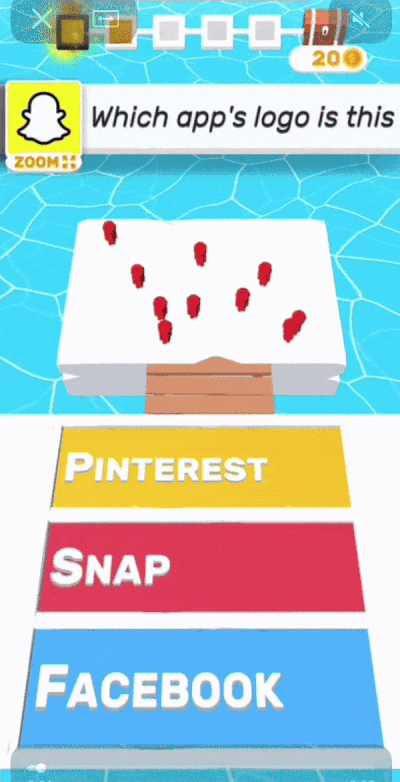· 8 min read
Best Trivia Games of Lockdown 2020 – Part three

Sarah Impey
Content Creator at GameAnalytics
In the last two parts of this series, we’ve explored which casual games sauntered to the top charts and how social games united people across platforms.
Now, which other genre could possibly give these a run for their money?
If you guessed trivia – the headline was probably a giveaway – you win a brand-new, all-inclusive holiday to the Isle of Analysis. On your left, you’ll see the tiny village of Facts and Figures, while on the right we’ve got three titans, battling for the summit of Mt Saint Quiz.
All aboard, it’s time to learn some trivia.
How did lockdown affect trivia games?
People seem to love filling time with trivia games. While it might be short bursts of eight minutes, they log on often. Just over 5 sessions a day on average, working out to about half an hour of playtime in total.
It’s likely this is a sign people are filling in bathroom breaks, quizzing on the throne, or while they’re waiting for their pizza to cook. Trivia games clearly grab people’s attention, but much less than other genres. One session for social totals the same as the average playtime for trivia.
But boy do they come back.
Day seven retention is over 16% (40% for day one). People might play trivia for less time, but they return over and over again. They can’t keep away.
And – as any psychologist will tell you – that’s important if you want people to build a habit. The more they return, the more likely they’ll keep returning. So what are these games doing that’s proving so popular? Let’s see what we can learn.
Brain Test: Tricky Puzzles (UniCo Studio)
- Short: 5/5
- Simple: 4/5
- Satisfying: 3/5
Brain Test is the epitome of trick questions. It leads you down the wrong path, hides the answer behind obstacles, gives tough math problems and poses riddles like a Sphinx guarding treasure.
The game is deliberately frustrating. After a while, once you’ve grown accustomed to its tricks, it changes tact and surprises you yet again. The aim isn’t really to get the questions right, but to be entertained by all the clever ways the game will mislead you.
Keep the tone consistent
As a game deliberately filled with frustration, it’s important to strike the right note. Too frustrating, without enough tongue-in-cheek humor, and the player will give up immediately.
UniCo set that tone up from the start. In the store description, they warn players that they’ll be tricked. When you load up the game, the artwork looks hand-drawn and doodled. And the language is deliberately lighthearted, teasing you like an old friend.
That consistency is important. If the player suddenly gets a different style when browsing through your menus or downloading some extra content, it’s going to jar and they’re going to start feeling that frustration for real. This is true whatever game you’re creating. If it’s serious, a menu item with a quirky message will feel odd and break the immersion.
So unless you’re making a deliberate point to break your tone for narrative reasons, it’s best to pick one early and keep it through the whole experience.
Balance difficulty and reward
Rewards need to be clear to the player. Just answering a question correctly, doesn’t necessarily feel satisfying. Currency is always a good reward, or you might open up new mechanics and features.
The trick is to set expectations for the player. Hint at what they’re going to unlock so they can feel that progression towards something.
Brain Test can fall down on this sometimes. While it’s very satisfying to answer a tricky question, it’s not clear enough what you’re progressing towards. Are you unlocking new kinds of levels? New features? Just challenging yourself? If you don’t signpost those rewards, the difficulty of answering the question can outweigh the reward of solving it.
In the case of Brain Test, this is very dependent on the type of player. Some people will get enough of a reward, just from getting the answer right. But a lot of people won’t bother continuing as there’s no clear reason to keep torturing themselves.
So use a wide group of testers, to make sure your rewards work for as many people as possible.
Trivia.io (8SEC)
- Simple: 5/5
- Short: 5/5
- Satisfying: 5/5

Trivia.io is a typical quiz game with a clever twist. Rather than having only one guess, you have a group of teeny tiny people you can assign to answers. You get points based on how many of your people are on the correct answer, and you lose any on a wrong answer.
This creates some interesting gameplay, usually missing from trivia: strategy. Usually, if you don’t know the answer, you fail and have to start again. But in Trivia.io, you can hedge your bets and split your people across multiple answers, just in case. You won’t get as many points, but you can keep playing.
Make every strategy rewarding
Whenever you add a new feature, it’s important that it feels like you’re meant to play the game that way. For example, in Trivia.io you can either buy more people or make each person give you more points.
This helps either strategy. If you’re someone who likes to take risks and bet all-in, you can invest in more value. But if you like to play it safe, you can get more people and spread out more.
The key is that either way feels correct. It feels like the game is encouraging you to choose a lane, but that either lane is fine.
Rethink how you use lives
The individual people you put on an answer are essentially your lives. Turning them into a currency is an extremely clever idea from 8SEC.
Lives are a little archaic, they come from a time of arcades and forcing players to pay more to continue playing. But nowadays, they’re a way to instill a sense of peril.
It’s a shame that they’re mostly passive. You lose lives, sometimes there’s a way to get them back, but generally your only interaction with them is when you do something wrong. Why? There’s no reason to keep them so separate. Brain Test reinvents this in a clever way, by giving them a new purpose.
Imagine if in an RPG you could trade in the amount of times you could quicksave to get a better weapon. Would you take that risk? Or imagine you could bet on a boss battle and get back double the lives you had, but lose your save completely if you failed. Giving the player more interactions with usually abstract mechanics, reintroduces that sense of peril. That sense of actually taking a risk.
Word Nut (Super Nutty Games)
- Simple: 5/5
- Short: 5/5
- Satisfying: 5/5
A game for crossword fans. You get a selection of letters and must find all the words to populate the crossword grid on the screen. Extremely simple, but very addictive.
Consider the seven types of intelligence
Why is this such a satisfying style of game? You can ask the same about crosswords in general, or scrabble, or sudoku. These classic games usually target a very specific kind of intelligence.
There’s a theory in psychology from a chap called Gardner, who thought there were different kinds of intelligence. The main seven are:
- Linguistic – (Word smart) – Understanding language and communication.
- Logical – (Number smart) – Being able to solve problems, organize and understand mathematics.
- Kinaesthetic – (Body smart) – Being able to control and understand how the body moves.
- Spatial – (Picture smart) – Being able to draw, sculpt, or generally create pictures.
- Musical – (Sound smart) – Understand notes, tunes, and noise.
- Interpersonal – (People smart) – Understanding social etiquette, people, and how they feel.
- Intrapersonal – (Self smart) – Understanding yourself and your feelings.
People can obviously be intelligent in more than one area. But when designing a game, it’s good to ask yourself which kind of intelligence you’re appealing to.
A crossword game clearly targets word-smart people, which makes it easier to design it. But could you do the same for your game? Do you know what kind of intelligence you’re targeting?
Help them build a habit
Trivia games show us that people will keep returning to a satisfying game, over and over again. And it comes down to how much you reward them, how quickly you scratch that itch, and how you tickle the right parts of their brain.
You can’t win everyone over. But win over those core players, and get them to keep coming back, even for only a few minutes, and you’ll have a game that’ll stand the test of time.
In the meantime, make sure to check out part one and part two of our lockdown series.